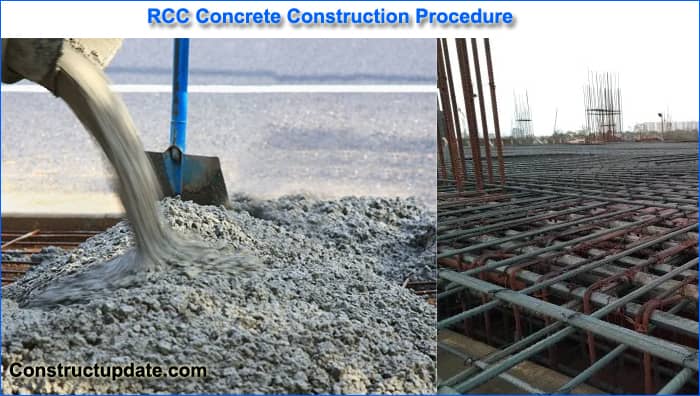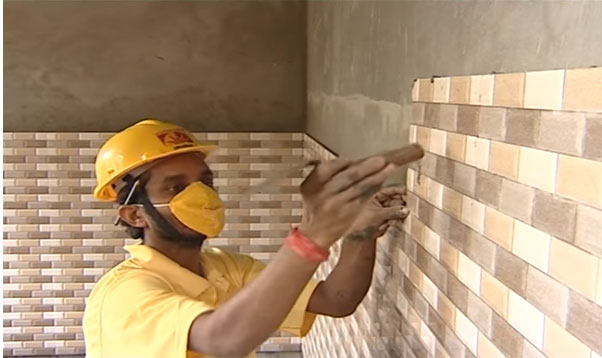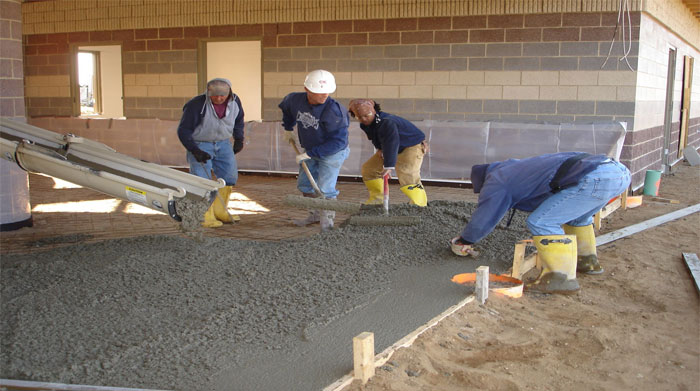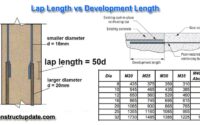RCC Concrete Construction Procedure – Procedure for Reinforced Concrete Construction (RCC)
RCC Concrete building for Reinforcement Concrete(RCC), concrete slab foundation, concrete residential construction, patio pavers, cement binder, and driveway are difficult tasks, and a set of guidelines must be followed for proper High strength RCC structures and for their durability.
RCC Concrete Construction
Placing of Concrete
Only when the Employer’s Representative or his approved representative is present is concrete poured. Surfaces or construction joints where fresh concrete is to be installed are flushed with a coat of neat cement grout or covered with a coating of mortar that is around 3 cm thick after the surface has been suitably prepared.
Unless otherwise specified, the mortar has the same amount of cement and sand as normal concrete. The mortar’s water-to-cement ratio is suitable for application and use in accordance with the instructions provided here. The mortar is applied evenly and thoroughly rubbed into any surface flaws.
The fresh mortar was then quickly covered with concrete. When laying concrete against formed building joints, meticulous puddling and spading with the help of the appropriate tools is used to create specific contact with the surface of the joints.
Concrete cannot be retempered under any circumstances. Any concrete that has stiffened to the point where proper placement cannot be guaranteed will be scrapped, and the contractor will not be compensated for the wasted material.
Concrete should never flow in a way that would facilitate or encourage segregation; instead, it should always be dumped as nearly directly in its final position as is practical. It is not permitted to allow excessive separation of coarse aggregates in concrete, which would result from letting the concrete fall freely from an excessive height or at an excessive angle from the vertical, or strike the forms or reinforcement steel.

Instead, the contractor should provide suitable drop chutes and baffles to contain and control the falling concrete in areas where excessive separation would otherwise occur.
All formed concrete is laid out in horizontal layers that are continuous, with the exception of joints, and whose depths typically do not exceed 50 cm. Where concrete cannot be laid in 50 cm layers as required by this standard, the Employer’s Representative maintains the right to demand lower layer depths. Unless otherwise indicated on the Drawings as requested by the Employer’s Representative, all intersections of construction joints with concrete surfaces that will be visible are made straight, level, or plumb.
Large Blocks: In order to keep the exposed area of fresh concrete in large, thick exposed areas to a minimum, the contractor must first build up the concrete to the full width of the structure and the full height of the lift over a small area at one end of the structure, and then continue in similar, progressive stages across the structure to cover the entire area. In order to minimise its area, the slope created by the unrestrained edges of concrete is kept as steep as is practical.
Except when conditions are such that the concrete will harden to a point where later vibrations will not fully consolidate and integrate it with more recently placed adjacent concrete, concrete along these edges is not vibrated until adjacent concrete in the layer is placed. Before fresh concrete is poured on top of the old, big aggregate clusters are dispersed. Unless suitable construction joints can be established, concrete installation in a structure cannot be stopped once it has started.
Rain: When it is raining heavily or for an extended period of time, mortar from coarse aggregate on the slopes of the placement cannot be washed away. Mortar should not be applied to building joints during such downpours, and any previously applied diluted mortar should be removed and replenished before moving further with the project.
Buckets: When employed, concrete buckets may quickly discharge the appropriate low-slump concrete mixes, and the dumping mechanism is made to allow the discharge of as little as 0.35 m3 of the load at a time. When used in limited spaces, buckets are appropriate for attachment to and usage with drop chutes.
Transportation, Placing & Compaction:
- Transit mixers must deliver concrete from batching plants to pouring places. Concrete must be poured as soon as it arrives at the working site.
- Chute usage is required for in-depth concreting. The vertical drop shouldn’t be higher than 1.5 metres.
- Concrete must be mechanically vibrated to be compacted as soon as it has been poured into the formwork.
- In order to prevent over- or under-vibration, immersion-type vibrators must be put in a vertical position.
- All safety precautions must be used when moving and putting concrete in order to prevent any kind of quality degradation.
- The vibration, hounding, and mounding of concrete between successive batches must be done with care. The area must be adequately cleaned before putting concrete.
- To prevent re-handling, concrete must be deposited as close to its final location as is practical.
- Before pouring concrete, all metal inserts, anchor bolts, pipe sleeves, etc. must be fixed in accordance with the relevant drawing, and that must be examined with respect to its lines and levels. Electrical conduits, pipes, fittings, etc. must first be installed as needed.
Concrete Temperature
Concrete is typically put at a temperature of no higher than 300C. When it’s hot outside, concrete is mixed on the construction site and then put in place right away.
The contractor could take the necessary actions to keep the temperature of the concrete below the above-specified level if the weather conditions cause the temperature to climb over + 320 C. (e.g. placing of concrete during the night).
Taking Down Forms
The Employer’s Representative must approve the timing and procedure for removing and shifting the forms, and care must be taken to prevent damage to the concrete. Concrete that is still “green” cannot be loaded. The concrete’s surface is thoroughly inspected when the forms are taken off, and any surface abnormalities are promptly fixed to the Employer’s Representative’s satisfaction.
For unloaded walls and other side forms, the minimum amount of time between the placement of the concrete and the removal of the forms is two days. For supporting walls and conduits, the minimum amount of time is seven days, and for bridge decks, it is fourteen days.
Concrete Curing and Surface Protection
All concrete is cured using either water or a sealing compound with white pigment, as will be explained further. The method of curing to be employed by the Contractor in each section of the work to prevent damage may be chosen by the Employer’s Representative.
Water-cured concrete must be kept moist for at least fourteen days straight after installation, starting as soon as the concrete has adequately hardened to prevent harm. The process of curing involves covering the exposed concrete surfaces and the forms with a material saturated with water, a network of perforated pipes, mechanical sprinklers, or porous hose, or by any other means that has been approved and will keep all surfaces continuously (not sometimes) wet throughout the curing process. Water used for curing must adhere to the specifications for water used in concrete mixing.
All exposed concrete surfaces are shielded from the sun’s direct access for at least the first three days following placement, with the exception of those covered with white pigmented sealing compound. As soon as is reasonably possible after the removal of the forms, this protection becomes effective. All concrete must be protected by the Contractor against damage until it has been fully accepted by the Employer’s Representative.
Finishing of Unformed Surfaces: The following are the finish clauses for unformed surfaces:
Unformed surfaces that are covered with concrete or backfill are given a smooth, level finish with sufficient levelling and screening. Surface flaws shouldn’t be larger than 1.9 cm, as determined by the measurement described in paragraph D above.
A sturdy steel trowel finish is applied to unformed surfaces that have been impacted by running water. Vehicle and pedestrian traffic on bridge decks often use surfaces with a light broomed finish. For floating and trowelling, equipment that is driven or operated by hand is employed. Floating and trowelling are started as soon as the screened surface has sufficiently consolidated and reached the minimal level necessary to produce a surface free of screed marks and with a homogeneous texture.
Surface irregularities, as measured in accordance with the method described in paragraph D above, shall not be greater than 6 mm and neither trowel marks nor sudden abnormalities are permitted. Joints and edges are tooled.
Repairing Concrete Surface
If any concrete is discovered to not have been formed as depicted on the Drawings, to be out of level, or to have a defective surface after the forms have been stripped away, it is deemed to not have been constructed in accordance with the intent of the specification and must be removed and replaced by the Contractor within 72 hours of the concrete’s age at his expense unless the Employer’s Representative gives permission to patch the problem area, in which case the patching described in the following paragraphs must be done.
Honeycombs, form-related damage, loose concrete fragments, bolt holes, tie-rod holes, ridges at formed joints, and bulges brought on by the movement of the forms are examples of defects that call for replacement or repair.
Ridges and bulges eliminated through tooling or chipping, then rubbing with a grinding stone.
Concrete that was honeycombed or otherwise flawed was chipped out, and the gaps left behind were sharply edged and contoured so that the filler fit perfectly. Before the filling is applied, all holes must be properly wet for 24 hours. The filling’s surface or finish is identical in texture to the surrounding concrete surface. To the satisfaction of the Employer’s Representative, all patches have reached the concrete curing standards mentioned above.
A non-shrink patching compound that has been approved by the employer’s representative in the amount specified by the manufacturer, along with just enough water, should be used to fill in imperfections, bolt and tie-rod holes, and chipped out honeycomb areas that need to be repaired. After the ingredients are thoroughly mixed, the mortar should stick together when being moulded. Thin layers of mortar repairs are applied, and then they are completely compacted using the right tools. Rod, bolt, and pipe holes should be filled carefully so that mortar is compacted to the depths of the holes.
Where concrete will be visible, the mortar will be prepared to match the colour of the concrete by replacing a specified amount of normal cement with white Portland cement.
The Contractor is required to apply a sack-rubbed mortar finish to such surfaces and adjacent surfaces in accordance with the Employer’s Representative’s instructions when, in the Employer’s Representative’s opinion, the extent of the imperfections in structures exposed to view is such that patching alone cannot produce a surface of satisfactory appearance.




